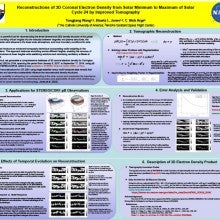Reconstructions of 3D Coronal Electron Density from Solar Minimum to Maximum of Solar Cycle 24 by Improved Tomography
Tongjiang
Wang
Catholic University of America and NASA's GSFC
Shaela I. Jones, Catholic University of America and NASA's GSFC
C. N. Arge., NASA's GSFC
C. N. Arge., NASA's GSFC
Poster
Tomography is a powerful tool for reconstructing the three-dimensional (3D) density structure of the global solar corona, providing critical insights into the interplay between magnetic and plasma structures, the connection of solar wind streams to the lower solar atmosphere, and inner boundary conditions for solar wind models. In this study, we introduce an enhanced tomography technique incorporating radial weighting in the regularization term. This approach balances smoothing across different heights, enabling the recovery of finer density structures at lower heights while stabilizing solutions and minimizing oscillatory artifacts at greater heights.
Using this method, we generated a comprehensive database of 3D coronal electron density distributions for Carrington Rotations (CRs) 2052 to 2154, spanning the period from January 8, 2007, to September 17, 2014, based on STEREO/COR1B data. For CR 2098, radial weighting effectively mitigates over-smoothing near the inner boundary observed with second-order smoothing and significantly enhances reconstruction quality when zeroth-order smoothing is applied. Furthermore, a comparison of reconstructions for CR 2091 using single-satellite versus multi-viewpoint data reveals that coronal evolution and dynamics substantially influence the reconstructed density structures.
Finally, we explore potential applications of this technique for density reconstructions using data from LASCO/C3, STEREO/COR2, and the upcoming PUNCH/NFI mission. We highlight its versatility in advancing our understanding of the solar corona and emphasize the importance of 3D coronal density reconstructions in enhancing the accuracy and applicability of solar wind models (e.g., the WSA model) for space weather forecasting.
Using this method, we generated a comprehensive database of 3D coronal electron density distributions for Carrington Rotations (CRs) 2052 to 2154, spanning the period from January 8, 2007, to September 17, 2014, based on STEREO/COR1B data. For CR 2098, radial weighting effectively mitigates over-smoothing near the inner boundary observed with second-order smoothing and significantly enhances reconstruction quality when zeroth-order smoothing is applied. Furthermore, a comparison of reconstructions for CR 2091 using single-satellite versus multi-viewpoint data reveals that coronal evolution and dynamics substantially influence the reconstructed density structures.
Finally, we explore potential applications of this technique for density reconstructions using data from LASCO/C3, STEREO/COR2, and the upcoming PUNCH/NFI mission. We highlight its versatility in advancing our understanding of the solar corona and emphasize the importance of 3D coronal density reconstructions in enhancing the accuracy and applicability of solar wind models (e.g., the WSA model) for space weather forecasting.

Poster PDF
Meeting homepage